Commitment to Prosperity Through Peace
2011-10-14ByYINPUMIN
By YIN PUMIN
Commitment to Prosperity Through Peace
By YIN PUMIN
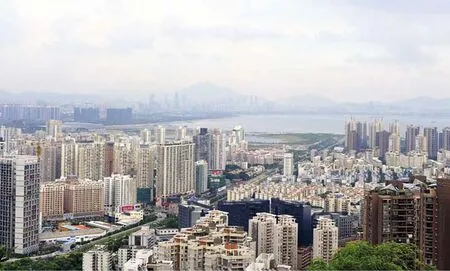
GROWTH ENGINE: The Shekou Industrial Zone, established in 1979 in Shenzhen, Guangdong Province, is China’s first export-oriented manufacturing base
China believes peaceful development is its only path to prosperity
The Chinese Government published a white paper on the country’s development on September 6, stressing that peaceful development is the best means through which China can realize its ambitions for modernization and prosperity.
The white paper, titled China’s Peaceful Development, was released by the State Council Information Of fi ce.
Zhou Wenzhong, China’s former ambassador to the United States, said that the white paper has come amid signi fi cant changes in the international situation. “It requires China to reflect upon and develop the model of peaceful development, expand on its implications, and demonstrate its sincerity to the world,” he said.
“The white paper also clari fi es the doubts of those who question China’s strategic intentions,” Zhou said.
Wang Yizhou, Vice Dean of the School of International Studies of Peking University, said the white paper also aims to unify thoughts at home as “some domestic voices argue China should be more aggressive on the international stage.”
“It tells the public that China should remain modest and prudent in its diplomacy,”he said.
A unique path
Stressing that China will unswervingly follow the path of peaceful development, the white paper says this is “a path of scienti fi c,independent, open, peaceful, cooperative and common development.”
Meng Xiangqing, Deputy Director of the Institute for Strategic Studies at the National Defense University, said that since the publication of the last white paper on China’s roadmap for peaceful development in 2005,China has made great strides.
According to the white paper, the material basis for China’s modernization drive has become more solid. The country’s total economic output reached $5.88 trillion in 2010,accounting for 9.3 percent of the world’s total GDP. China’s per-capita income has now reached 46.8 percent of the world average, up from 24.9 percent in 2005.
China now plays an active part in economic globalization and regional economic cooperation and has made a vital contribution to the stability of the world’s economy.
“Last year China’s GDP surpassed Japan’s and its international status has risen considerably, however this rise has raised concerns about how China will exert its new found strength,” Meng said. “In such a context, China should tell the world, in an unequivocal way, what kind of development path the country is taking.”
Qu Xing, Director of the China Institute of International Studies, said that China’s basic national conditions have determined that the country has no choice but to choose the path of peaceful development.
China has a large population, and despite its growth the country’s economic base still has several weaknesses. It has to feed close to 20 percent of the world’s population with 7.9 percent of the world’s farmland and 6.5 percent of the world’s fresh water.
China’s social and economic develop-ment must meet the needs of 1.3 billion people, and the country’s per-capita GDP in 2010 remained about $4,400, ranking around 100th in the world.
“China will remain a developing country for a long time to come, which means that China must dedicate itself to promoting development and improving its people’s livelihood. This calls for maintaining a peaceful and stable international environment and conducting international exchanges and cooperation,” says the white paper.
“Peaceful development is a strategic choice made by China to realize modernization, make itself strong and prosperous, and make a contribution to the progress of human civilization,” Qu said.
China will never engage in aggression orexpansion, and will never seek hegemony,according to the white paper. In addition, it provides assistance to other countries and regions as its capacity permits.
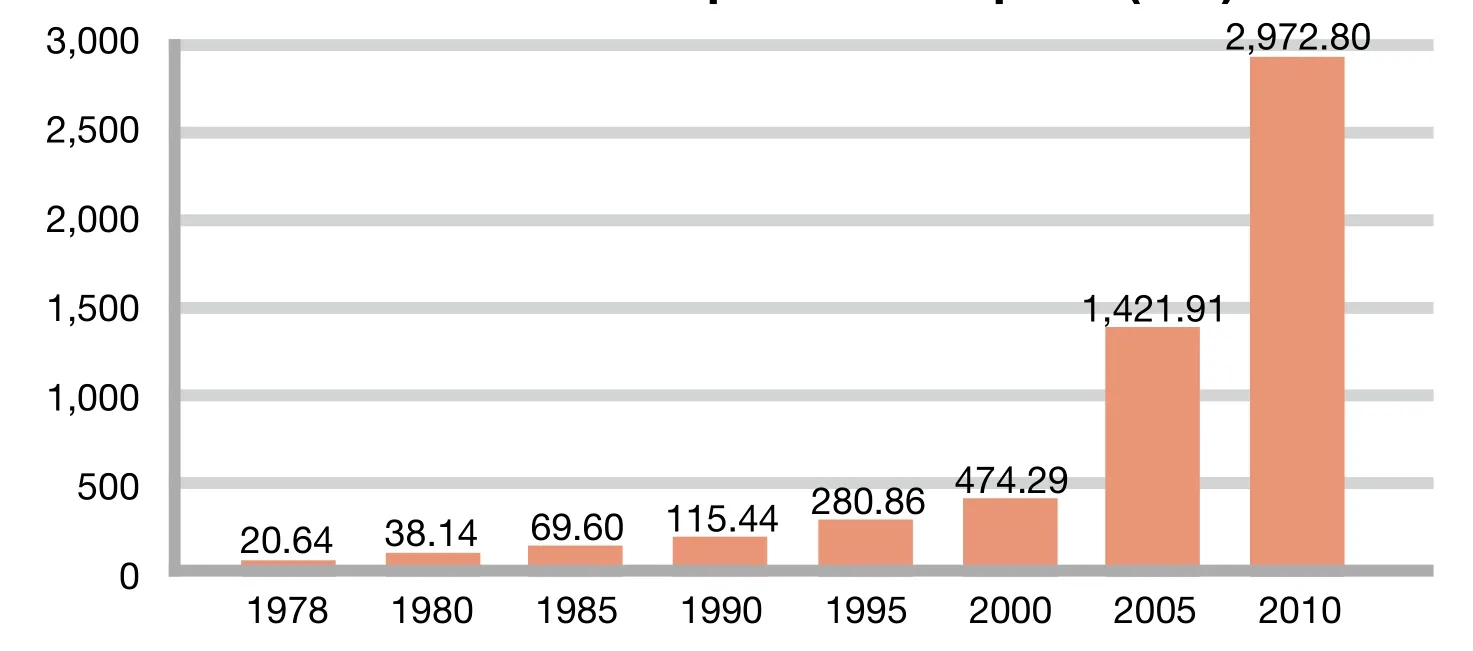
China’s Volume of Imports and Exports ($bn)
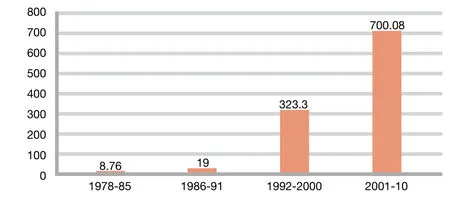
Foreign Direct Investment in China ($bn)
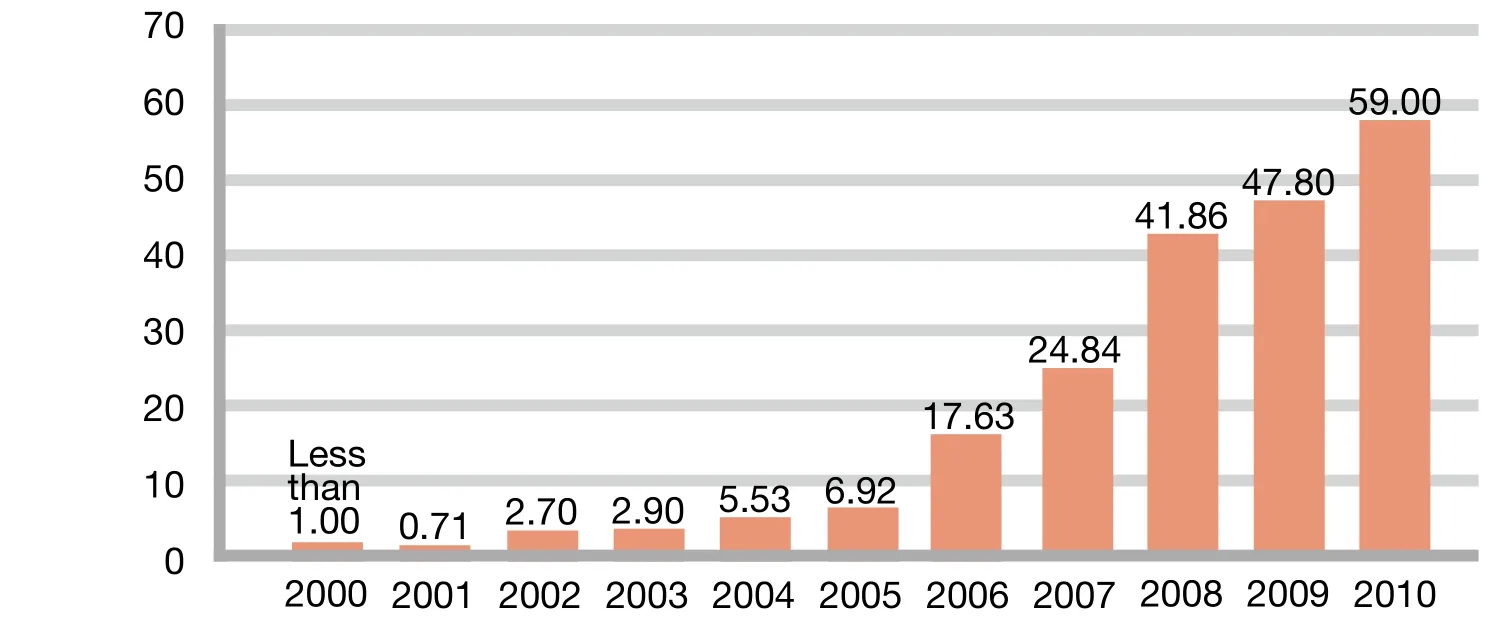
China’s Non-financial Outbound Direct Investment ($bn)
“China holds a consistent policy that it will seek neither military expansion nor an arms race with any other country, as indicated by the low proportion of its GDP its spends on the military,” Meng said.
In 2010, China’s national defense budget was only 6.3 percent of its fi scal revenues.
“The central goal of China’s diplomacy is to create a peaceful and stable international environment for its development,” Qu said.
Common development
China’s goal in terms of pursuing peaceful development is to promote domestic harmony and pursue cooperation and peace internationally, says the white paper. This has become a national commitment, which is already manifested in the strategies for national development and progress China has adopted over the past decades.
“That peaceful development has now been raised to the status of a national commitment indicates that the path will be a longterm strategy,” said Yan Xuetong, Director of the Institute of International Studies at Tsinghua University.
Specifically, this means that China will endeavor to make life better for its people and contribute to human progress through hard work, innovation and mutually bene fi cial arrangements with other countries.
To reach these goals, China will continue to pursue the basic state policy of opening up to the outside world. The government will work to increase the ease of conducting foreign trade, and continue to open China’s financial markets and its financial sectors,says the white paper.
“For the fi rst time, the white paper links the development and transformation of the Chinese economy with the prosperity of the world economy,” said Wang Yiming,Director of the Academy of Macroeconomic Research of the National Development and Reform Commission of China.
China will encourage its companies to invest overseas and engage in joint ventures with foreign partners. “Chinese companies operating overseas will improve the lives of local people and enhance the ability of host countries to develop themselves,” Wang said.
According to the white paper, China’s accumulated imports volume is expected to reach $8 trillion in the next fi ve years, which will create more business opportunities for other countries.
The size of China’s population and its total economic output mean its domestic market is potentially the largest in the world.
“This creates more business opportunities for other countries,” Wang said.
A new concept of security
For the fi rst time, the white paper clearly sets out China’s six core national interests,which are; sovereignty, national security,territorial integrity, national reuni fi cation, the development of the country’s political system and overall social stability.
In the past 20 years, there was no clear de fi nition of China’s national interests in political and academic circles, Meng said.
“This document tells our people and the world what China’s bottom line is. That is very important. None of these core interests can be compromised,” he said.
The white paper points out that, as a key member of the international community,China is optimistic about the prospects for a peaceful future and its thinking on international relations and foreign policy conforms to the principles of peaceful development.
Broadly, this thinking includes promoting the building of a harmonious world,pursuing an independent foreign policy of peace, actively living up to international responsibilities and promoting regional cooperation.
In terms of comprehensive security,the white paper says that China’s security dimensions have changed as traditional and non-traditional security threats have become intertwined in the face of new global developments.
“The international community should appreciate the need to ensure security and adopt comprehensive measures to address security
Major Targets Set for the 12th Five-Year Plan Period(2011-15)
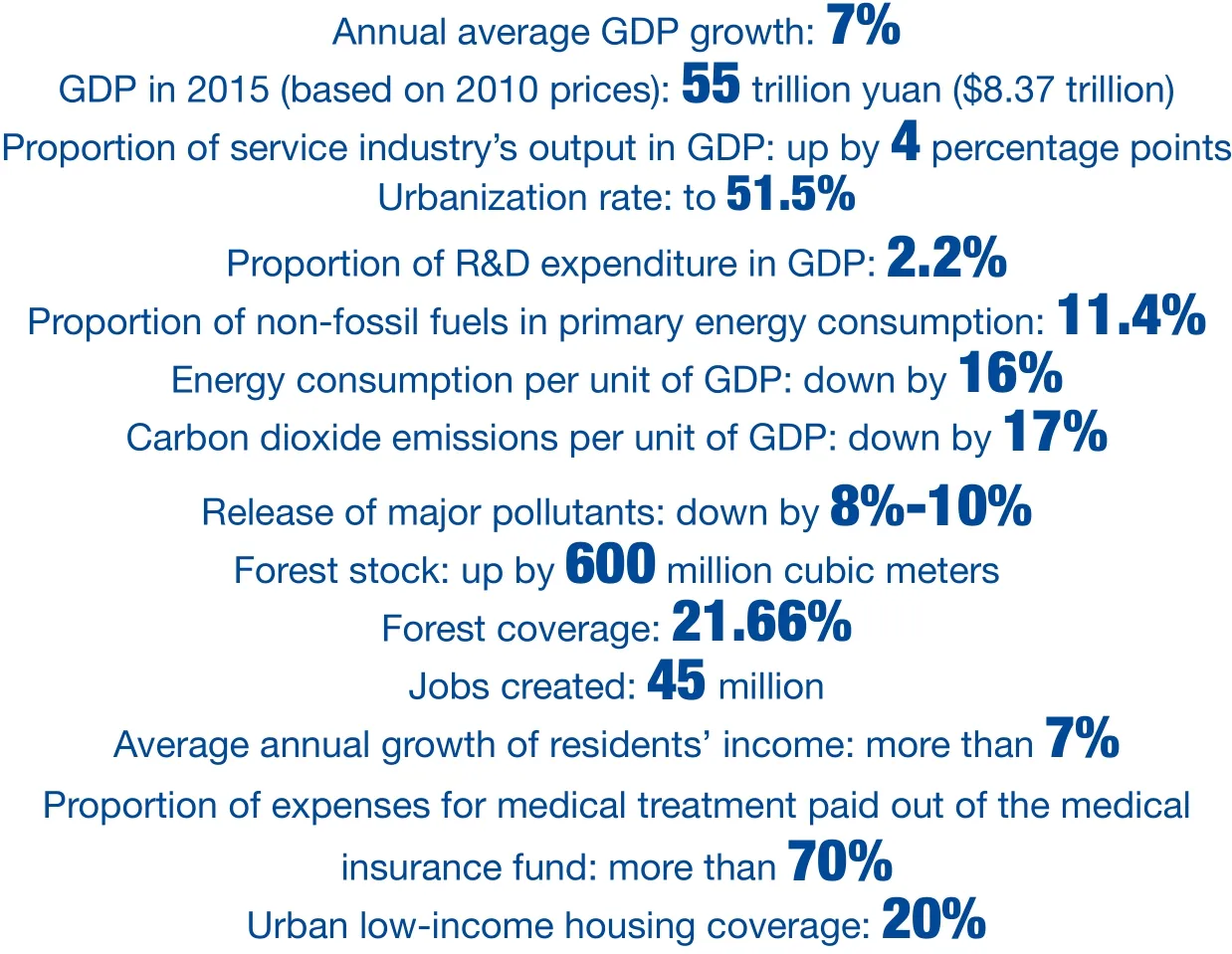
threats and their root causes, and countries around the world should work together to meet various challenges to security, “ Qu said.
The white paper says that due to globalization all the world’s nations have a common stake in the world’s security. Therefore it maintains that countries should safeguard their own security while respecting others’ security concerns. They should uphold common security through multilateral cooperation and work together to prevent con fl icts, it says.
“For China, the world’s most populous developing country, running itself well is the best way it can ful fi ll its international responsibilities,” Qu said.

(Left)DIRECT DIALOGUE:Chinese Defense Minister Liang Guanglie (right)meets with his Vietnamese counterpart Phung Quang Thanh at the ASEAN Defense Ministers’ Meeting Plus Eight in Hanoi,Viet Nam on October 12, 2010
Meanwhile, China has also actively participated in reforming international systems,formulating international rules and addressing global issues. It supports the development of other developing countries, and works to safeguard world peace and stability.
“Promoting regional cooperation and good-neighborly relations, China actively enhances friendly cooperation with its neighbors and works with them to promote a harmonious Asia,” says the white paper.
China calls on countries in the region to respect each other, increase mutual trust, and put aside their differences in order to safeguard regional peace, stability, and development.
According to the white paper, “China does not seek regional hegemony or a sphere of in fl uence, nor does it want to exclude any country from participating in regional cooperation.”
Global impact
“The path of peaceful development is a new development path and the global impact of this policy will become manifest over time.Its success calls for both the untiring efforts of the Chinese people and the understanding and support of the international community,” says the white paper.
“China’s peaceful development has broken away from the traditional pattern where a rising power was bound to seek hegemony,”Qu said. “The experiences of the past several decades have proved that China is correct in embarking upon the path of peaceful development, and there is no reason whatsoever for China to deviate from this path.”
In today’s ever-changing world, all doctrines, systems, models and paths are constantly subject to tests.
“As national conditions vary from country to country, there is no such thing as a fi xed mode of development that is effective and applicable in all cases. A path of development is viable only when it suits the national conditions of a country,” Qu said.
“China’s development path has taken shape in the Chinese environment. China is fully aware that taking the path of peaceful development is an important and long-term process at a time when the country and the world are going through profound and complex changes,” says the white paper.
China cannot develop itself in isolation from the rest of the world, and global prosperity and stability cannot be maintained without China. China’s achievements are inseparable from its friendly cooperation with the outside world, the white paper continues.
It concludes with the hope that the “international community will appreciate China’s need to settle, step by step, the various dif ficulties in development it faces as the world’s largest developing country.”
And the white paper asks that the international community have con fi dence in the Chinese people’s determination to achieve peaceful development, and support rather than obstruct China’s pursuit of a peaceful and prosperous future.
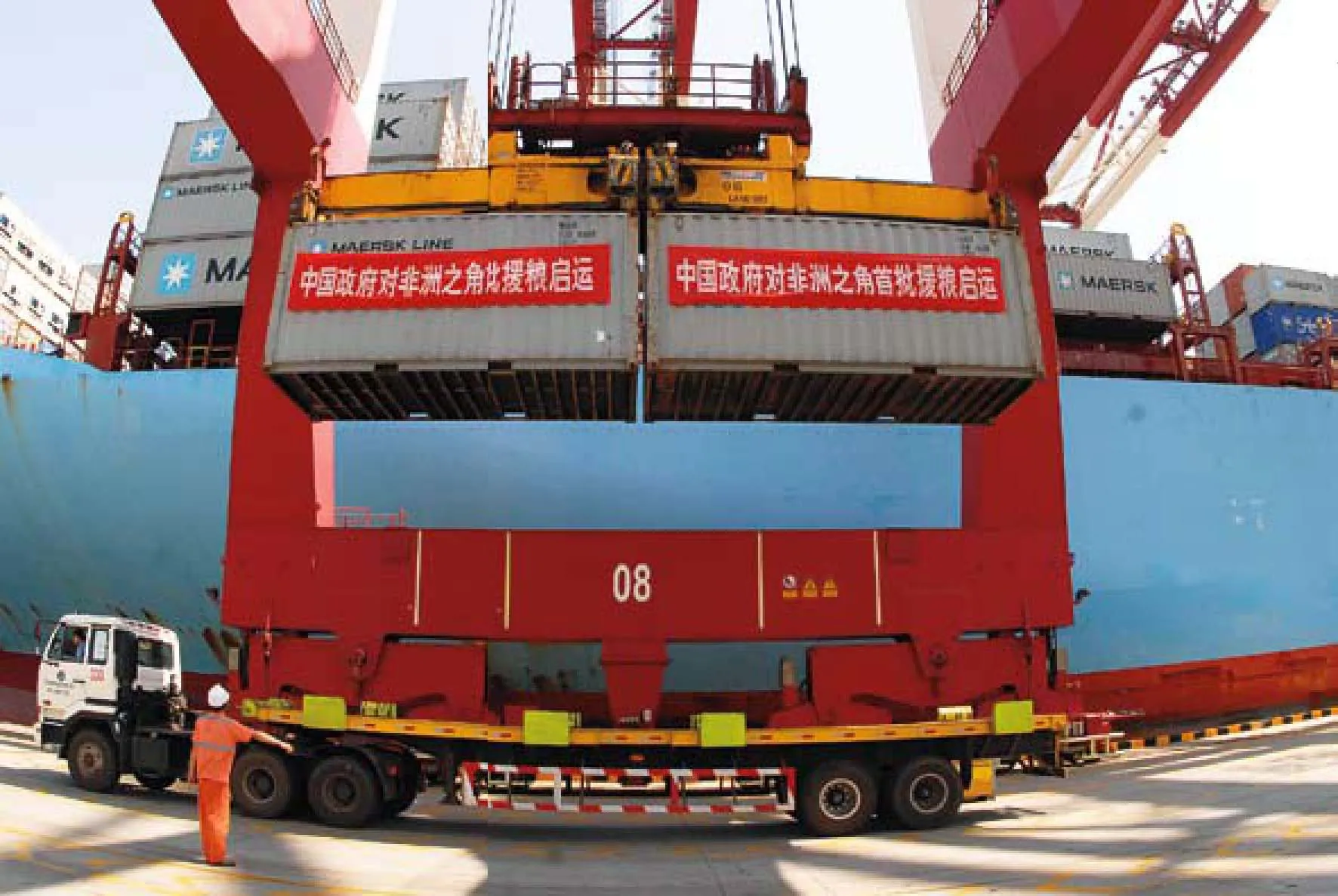
EMERGENCY AID:China’s first grain aid to the droughthit Horn of Africa region are loaded onto a container ship at Tianjin Port on September 2
